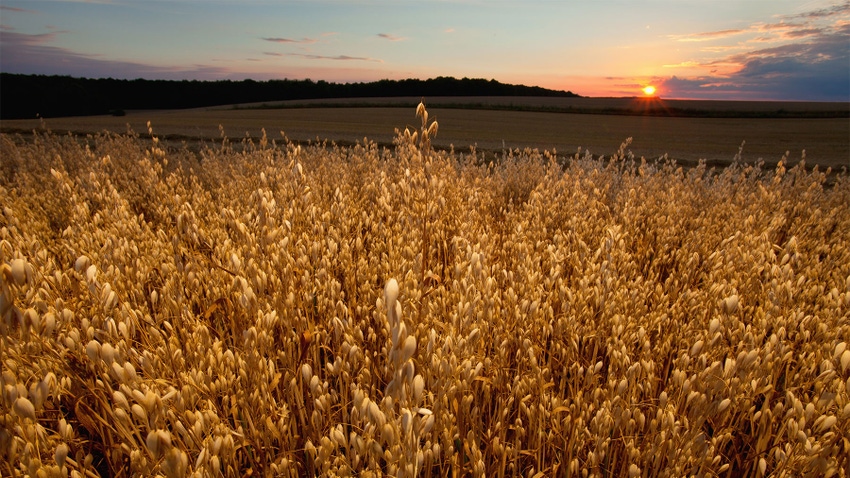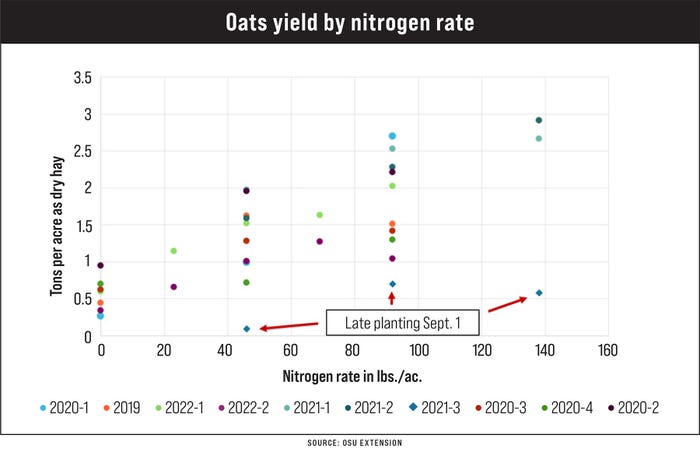August 2, 2023

by Jason Hartschuh and Al Gahler
This year has been another for the records books for challenging forage producers across Ohio and other areas lacking rainfall.
The drought decreased second-cutting yield across much of the state. And the subsequent shift to wetter conditions while not eliminating the drought made it very hard to harvest dry hay, lowering second cutting quality as it bloomed.
Quality was also lowered from diseases that infect forages during the hazy days caused by the smoke inversions in late June. If you are concerned your operation may be short on forage, now is the time to plant a summer annual forage to keep your livestock fed this winter — or give you additional forage inventory to sell.
Oats is traditionally planted as the first crop in early April as a grain crop or an early-season forage. One of the beauties of oats is their versatility in planting date. Oats can also be planted in the summer as an early-fall forage for harvest or grazing.
Summer oats have a wide planting window, but they perform much better with an application of nitrogen and may benefit from a fungicide application to improve quality. During summer 2019, we conducted a study to examine the planting of oats from July 15 through early September to examine tonnage and forage quality. Through this trial, we examined planting date, yield, forage quality and an application of foliar fungicide to control oats crown rust.
Usually, the best scenario for growing oats for forage is to plant them into wheat stubble, which is normally available by mid-July at the latest. However, the typical recommendation is to plant oats between Aug. 1 and Aug. 10 to maximize tonnage and quality, since the shorter day length triggers oats to grow more leaf instead of producing seed. But if planted too late in the year, there is not enough time for growth.
The oats in this study were harvested between 60 and 75 days after planting, with full head emergence. The chart shows how yield changed based on the planting date and nitrogen rate.
Similar to previous studies, applying 46 pounds of nitrogen significantly increased yield on all planting dates, but applying 92 pounds didn’t always increase yield significantly over 46 pounds of nitrogen. Adding this study to others, the recommended nitrogen rate for summer oat forage is to apply 50 pounds of nitrogen at planting.
When planted in early September, yields fall to an average of a half-ton per acre, making it less economical to mechanically harvest as stored forage and more economical to graze. In 2021, our oats research included a treatment of 138 pounds on the early September planting date. This high nitrogen rate pushed yields to 0.7 ton per acre with our early September planting date and about a half-ton in mid-September.
These oats plantings never made it to flowering like earlier planting dates. As a last-resort forage option, this may be a good management strategy, but early planting will return the best economic return or lower tonnage from more acres and grazing the late-planted oats. Our greatest nitrogen use efficiency over all planting dates and four years of oats work was when 92 pounds of nitrogen was applied, which gave us a nitrogen-use efficiency of 0.64.

Other summer options
Many other summer annuals such as sorghum, brown midrib sorghum, sorghum-sudangrass and short-season corn also make excellent forages after wheat. These crops can be harvested in a two-cut or one-cut system, but they usually return the greatest value to the farm when planted after wheat if managed for one cutting.
The nutritional value of these summer annual forages ranged from $200-$260 per ton. While it may not be possible to sell these forages for their nutritional value, this is what it would cost to replace these forages in the ration with other forms of protein, energy and fiber.
For producers looking at add value to their operation, the value per acre had a wide range from $100-$1,800 per acre. While the nutrition content of the crop is important to filling the needs of livestock, the driving factor of return per acre is the tons produced.
While some of these summer annuals can be harvested multiple times over the summer, we compared a single cutting at about 60 or 90 days after planting. Not surprisingly, across most species, the early July planting had increased yields but the ability to utilize these crops into a late-summer planting was surprising.
Early-July-planted corn yielded almost 7 tons of dry matter compared to late-July-planted corn only yielding about 2.5 tons. The reduction in yield was also found in sorghum more than other crops. Sorghum 90-day yield dropped from 4 tons per acre to about 2 tons with the later planting date. Both crops could have been grown until just before the first frost, increasing tonnage. Quality and tonnage peak, though, just before these crops switch from vegetative growth to reproductive.
Nitrogen is a driving factor of summer grass forage production. While our work was focused on using 50 pounds of nitrogen in the past, we have seen economic yield increase with up to 150 pounds of nitrogen, depending on growing conditions. A safer recommendation is to apply between 50 and 100 pounds of nitrogen based on the amount of growing season left to maximize production.
Hartschuh is the OSU Extension field specialist in dairy management and precision livestock. Gahler is the OSU Extension educator in Sandusky County for agriculture and natural resources, and both are members of the OSU Extension Beef Team. The Beef Team publishes the weekly Ohio BEEF Cattle letter, which is found at beef.osu.edu.
You May Also Like




